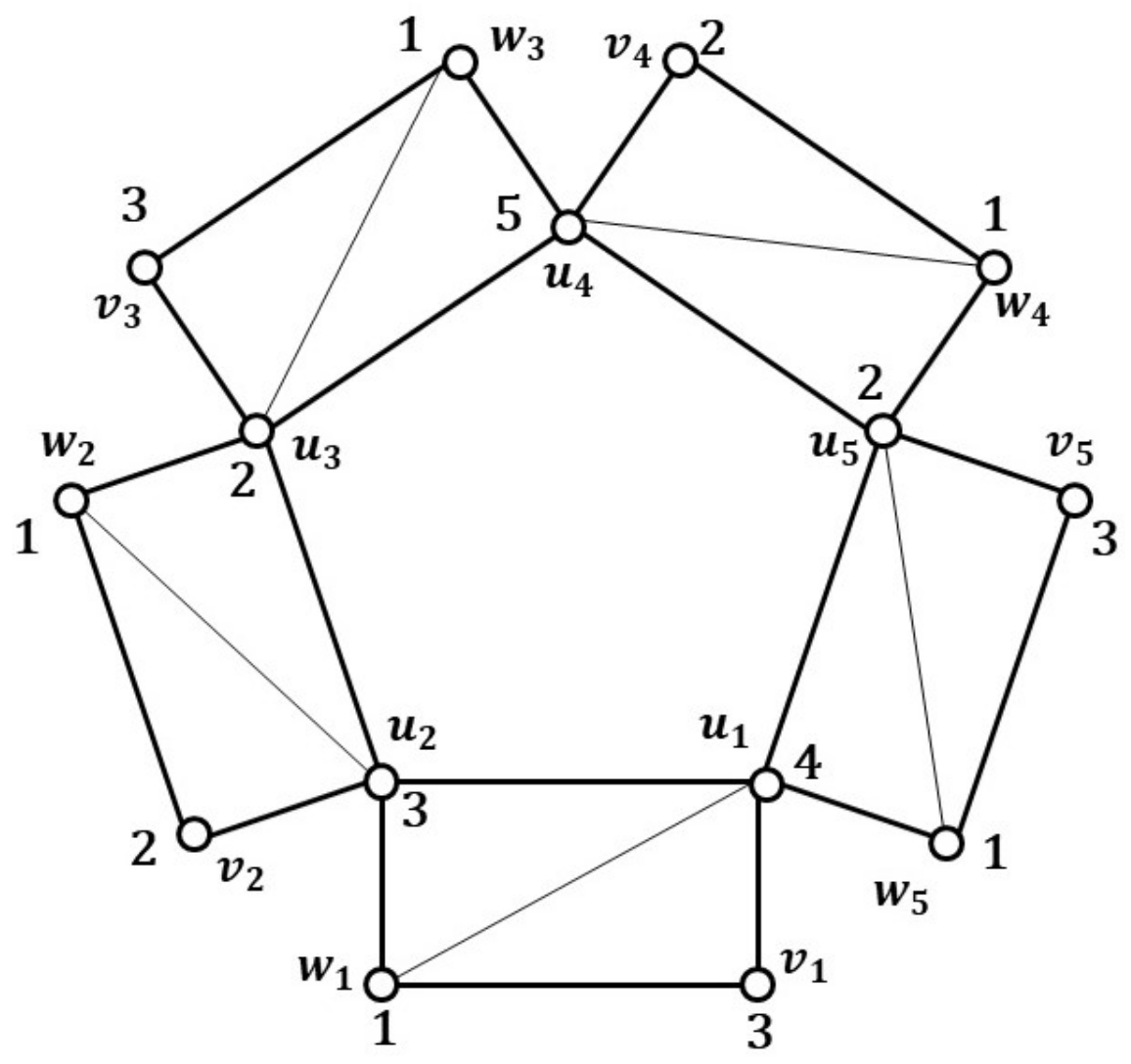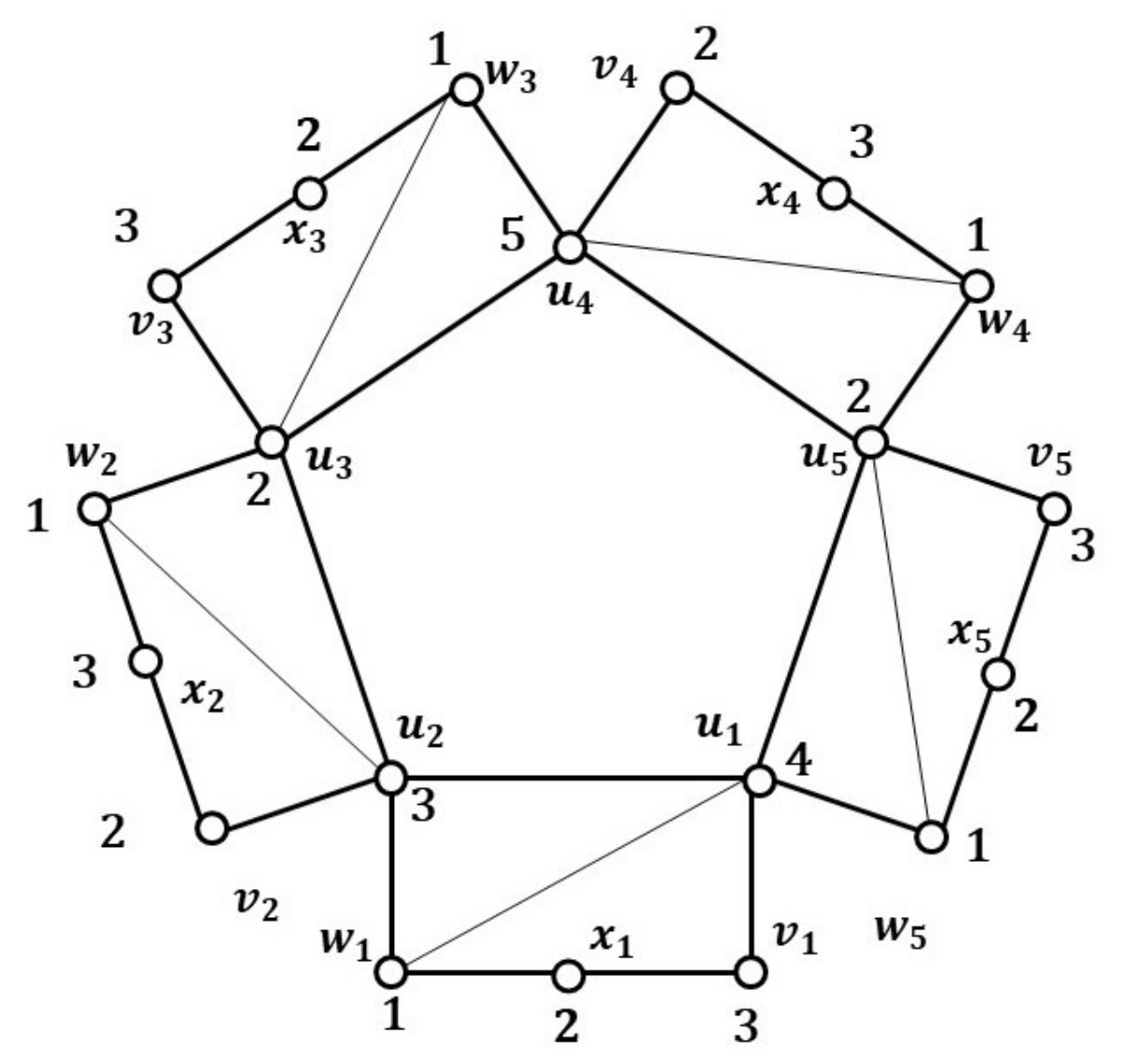2.1. Locating-Chromatic Number of Origami Graphs
Theorem 1. Let be an origami graph for . Then, the locating-chromatic number of ,
Proof. Let with . An origami graph is a graph with and ∪∪. Next, to prove the theorem, we consider the following two cases:
First, we determine the lower bound of . In the origami graphs for , there are three adjacent vertices (complete graph with three vertices, denoted by ); we then need at least 3-locating coloring. Without loss of generality, we assign three colors for any in for , and then the three vertices are dominant vertices. As a result, if we use three colors it is not enough because there are more than one in for . Therefore, .
Next, we determine the upper bound of . To show that 4 is an upper bound for the locating-chromatic number for the origami graph we describe a locating coloring c using four colors as follows:
The coloring c will create the partition on . We shall show that the color codes of all vertices in are different. We have: ; ; ; ; ; ; ; ; . Since the color codes of all vertices are different, c is a locating-chromatic coloring. Thus, .
Case 2. , for
To determine the lower bound, we will show that four colors are not enough. For a contradiction, assume that there exists a 4-locating coloring c on for . We assign , where because , . Observe that, on for , there are n vertices whose degree is 5. As a result, at least two vertices , have the same color codes, which is a contradiction. Therefore, , for .
To show the upper bound for the locating-chromatic number of origami graphs for , let us differentiate some subcases.
Subcase 1. (Odd n), for odd,
Let c be a coloring of origami graph , odd, and ; we make the partition of :
;
for odd ∪ for even ;
for even ∪ for even ∪ for odd ;
;
.
For odd, the color codes of all the vertices of are:
For
we have:
For
we have:
for odd ∪ for even .
For
i odd,
we have:
For
i odd,
we have:
For
i even,
we have:
For
, we have:
For
i even,
we have:
for even ∪ for even ∪ for odd
For
i odd,
we have:
For
i odd,
we have:
For
i even,
we have:
For
i even,
we have:
For
, we have:
For
, we have:
Since for n odd all vertices have different color codes, c is a locating coloring of origami graphs , so that , for odd, .
Subcase 2. (Odd n), for even, .
Let c be a coloring of origami graph , even, and ; we make the partition of as follows:
;
for odd ∪ for even ;
for even ∪ for even ∪ for odd ;
;
.
For even, the color codes of all the vertices of are:
For
we have:
For
we have:
for odd ∪ for even .
For
i odd,
we have:
For
i odd,
we have:
For
i even,
we have:
For
i even,
we have:
for even ∪ for even ∪ for odd
For
i odd,
we have:
For
i odd,
we have:
For
i even,
we have:
For
i even,
we have:
, we have:
Since for n odd all vertices have different color codes, c is a locating coloring of origami graphs , so that , for even, .
Subcase 3. (even n), for odd, .
Let c be a coloring of origami graph , odd, and ; we make the partition of :
;
for odd ∪ for even ;
for even ∪ for odd ;
;
.
For
odd, the color codes of all the vertices of
are:
For
we have:
For
we have:
for odd ∪ for even
For
i odd,
we have:
For
i odd,
we have:
For
i even,
we have:
For
i even,
we have:
for even ∪ for odd
For
i odd,
we have:
For
i odd,
we have:
For
i even,
we have:
For
i even,
we have:
For
, we have:
For
, we have:
Since for n even all vertices have different color codes, c is a locating coloring of origami graphs , so that , for odd, .
Subcase 4. (even n), for even, .
Let c be a coloring of origami graph , even, and ; we make the partition of as follows:
;
for odd ∪ for even ;
for even ∪ for odd ;
;
.
For even, the color codes of all the vertices of are:
For
we have:
For
we have:
for odd ∪ for even
For
i odd,
we have:
For
i odd,
we have:
For
i even,
we have:
For
i even,
we have:
for even ∪ for odd
For
i odd,
we have:
For
, we have:
For
i odd,
we have:
For
i even,
we have:
For
i even,
we have:
For
, we have:
For
, we have:
Since for n even all vertices have different color codes, c is a locating coloring of origami graphs , so that , for even, . this completes the proof of Theorem 1. □
Note that
Figure 1 is an example locating coloring for origami graph
.
2.2. Locating-Chromatic Number for Subdivision Outer Edge of Origami Graphs
Theorem 2. Let be a subdivision outer edge of origami graphs for . Then the locating-chromatic number of ,
Proof. Let , be a subdivision of an origami graph; is a graph with and ∪∪}. Next, to prove the theorem, we consider the following two cases:
Case A. First, we determine the lower bound of .
Without loss of generality, we assign . Then, there are three dominant vertices in A, while we still have vertices on other A that must be colored. As a result, there will be two vertices with the same color codes. Thus, .
Next, we determine the upper bound of . To show that 4 is an upper bound for the locating-chromatic number for a subdivision outer edge of origami graph , we describe a locating coloring c using four colors as follows:
The coloring c will create the partition on . We shall show that the color codes of all vertices in are different. We have: ; ; ; ; ; ; ; ; . ; ; . Since the color codes of all vertices are different, c is a locating-chromatic coloring. Thus, .
Case B. for
Since a subdivision of origami graphs for is obtained by origami graph with one added vertex in edge , we have for . The addition of one vertex on the outside does not reduce the number of colors needed because the number of the sets is the same.
To show the upper bound for the locating-chromatic number for a subdivision outer edge of origami graph for , let us consider different subcases.
Subcase a. (odd n), for odd, .
Let c be a coloring for a subdivision outer edge of origami graph , for odd, and ; we make the partition of :
;
for odd ∪ for even ∪ for odd ;
for even ∪ for even ∪ for odd ∪ for even ;
;
.
For for odd the color codes of all the vertices of are:
Since for n odd all vertices have different color codes, c is a locating coloring for subdivision of origami graph , so that , for odd, .
Subcase b. (odd n), for even, .
Let c be a coloring for a subdivision outer edge of origami graph , for even, and ; we make the partition of :
;
for odd ∪ for even ∪ for odd ;
for even ∪ for even ∪ for odd ∪ for even ;
;
.
For even, the color codes of all the vertices of are:
Since for n odd all vertices have different color codes, c is a locating coloring for a subdivision of the outer edge of origami graph , so that , for even, .
Subcase c. (even n), for odd, .
Let c be a coloring for a subdivision outer edge of origami graph , for odd, and ; we make the partition of :
;
for odd ∪ for even ∪ for odd ;
for even ∪ for odd ∪ for even ;
;
.
For odd, the color codes of all the vertices of are:
Since for n even all vertices have different color codes, c is a locating coloring for a subdivision of the outer edge of origami graph , so that , for odd, .
Subcase d. (even n), for even, .
Let c be a coloring of subdivision origami graph , for even, and ; we make the partition of :
;
for odd ∪ for even ∪ for odd ;
for even ∪ for odd ∪ for even ;
;
.
For even the color codes of all the vertices of are:
Since for n even all vertices have different color codes, c is a locating coloring for a subdivision outer edge of origami graph , so that , for even, . This completes the proof of Theorem 2. □
Note that
Figure 2 is an example locating coloring for a subdivision of the outer edge of origami graph
.







